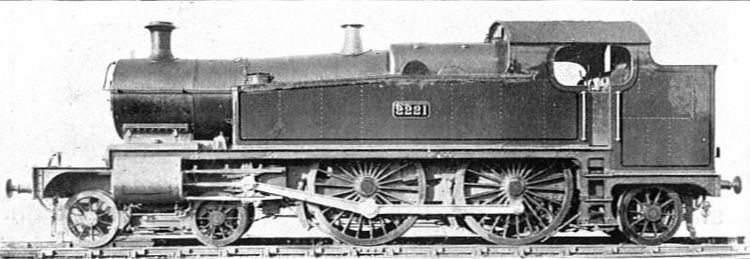Build date 1904, 1906, 1911–12 | Order number 149, 165, 184 | |
 | ||
Serial number 2056–65, 2209–28, 2415–25 | ||
The Great Western Railway County Class were a class of 4-4-0 steam locomotives for express passenger train work introduced in 1904 in a batch of ten. Two more batches followed in 1906 and 1912 with minor differences. They were designed by George Jackson Churchward, who used standard components to produce a four-coupled version of his Saint Class 4-6-0s.
Contents
Construction
The first locomotive, no. 3473 County of Middlesex, was built at Swindon Works in May 1904, with the following nine completed by October 1904. They were initially fitted with parallel-sided copper-capped chimneys, which were soon replaced by tapered cast iron chimneys. The second batch, of twenty, were built between October and December 1906. This batch had tapered cast iron chimneys from the start. A third and last batch of ten were built between December 1911 and February 1912. On these the footplates had curved drop ends at the cab and front bufferbeam. They were also fitted from new with a superheater and top feed. Chimneys were a larger version of the copper-capped type of the first batch. Coupled wheels had independent springing, without the compensating beams fitted between the axleboxes on Churchward's 4-6-0s. The cylinder block, including the piston valves and smokebox saddle, was constructed from two castings from the same pattern, bolted back to back, each casting containing one half of the saddle. The cab, boiler and coupled wheels were attached to plate frames. The cylinder block was carried on two bar frames, bolted to the front end of the plate frames. The piston valves were driven by Stephenson valve gear. The class were fitted with the Standard No. 4 boiler. One locomotive, no. 3805 County Kerry was fitted with a smaller Standard No. 2 boiler between November 1907 and May 1909.
Operation
They were the last new GWR 4-4-0 design and by far the most modern, with inside frames and outside cylinders. They were designed as a part of Churchward's standardisation plan, but were found to have a front end too powerful for the wheel arrangement and all were withdrawn by the early 1930s. They were designed, in part, for the Hereford to Shrewsbury LNWR line over which the GWR had running powers, but on which they were expressly forbidden to use 4-6-0 locomotives. The 4-4-0 Counties were in effect a shortened GWR 2900 Class, providing engines powerful enough for the trains but with the requisite four coupled wheels.
The key components were all proven but the combination was somewhat unhappy, and perhaps the least successful Churchward design. From the outset they were found to be rough riders but otherwise effective locos. All other GWR 4-4-0s were inside cylindered and none had a piston stroke greater than 26", whereas the 'County' had a 30" stroke driving a meagre 8' 6" wheelbase.
The County Class used the same cylinders and motion as Churchward's six-coupled locomotives, and required the same mass to counterbalance the reciprocating parts of the motion. However the weight required had to be divided between four driving wheels rather than six. The heavier balance weights produced a high level of wheel hammer blow; at 6 revolutions per second the hammer blow was 8 tons, compared with the 3.6 tons of the inside-cylindered City Class and the 6.4 tons of the six-coupled Saint Class. The left hand trailing axleboxes often developed hammering, which was caused by the amount of counterbalancing used.
This class were subject to the 1912 renumbering of GWR 4-4-0 locomotives, which saw the Bulldog class gathered together in the series 3300-3455, and other types renumbered out of that series. The County Class took numbers 3800-3839.
No. 3833 County of Dorset was the first to be withdrawn, in February 1930. By the middle of 1933 all had gone, the last survivor being no. 3834 County of Somerset, withdrawn in November of that year.
They were also the basis for the 'County Tank' GWR 2221 Class design, a 4-4-2T using the same basic design as the County but with a smaller and lighter boiler, and the replacement of the tender by the addition of side tanks, bunker and trailing axle.
Models
Hornby Railways manufacture a model of the 38xx in OO gauge. 3mm Scale Model Railways manufacture a model kit of the 38xx in TT gauge.
